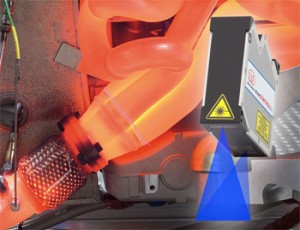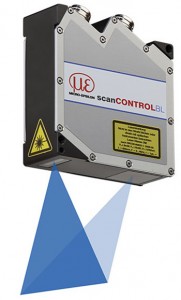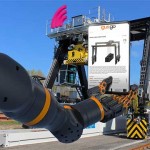Blue laser profile scanner for challenging targets
 Micro-Epsilon UK has launched a range of 2D/3D laser profile sensors (laser line scanners) that operate using blue (violet) laser technology rather than red. The special characteristics of the blue wavelength laser light make the scanners suitable for a wide range of high precision profile and dimensional measurements on a variety of materials including shiny surfaces, red-hot glowing metals, organic materials (for example food, wood and wood veneers), as well as transparent or semi-transparent materials such as plastics, glass, optical components and film/substrates.
Micro-Epsilon UK has launched a range of 2D/3D laser profile sensors (laser line scanners) that operate using blue (violet) laser technology rather than red. The special characteristics of the blue wavelength laser light make the scanners suitable for a wide range of high precision profile and dimensional measurements on a variety of materials including shiny surfaces, red-hot glowing metals, organic materials (for example food, wood and wood veneers), as well as transparent or semi-transparent materials such as plastics, glass, optical components and film/substrates.
The new scanCONTROL BL series offers similar features to Micro-Epsilon’s proven scanCONTROL series of laser profile scanners that use red laser technology. All the controls and electronics are integrated in an extremely lightweight, compact sensor design, enabling the scanners to be installed on robot arms where there may be little space available for mounting. The scanCONTROL BL series offers a range of interfaces and flexible installation options.
Chris Jones, Managing Director at Micro-Epsilon UK comments: “With red-hot glowing objects, a conventional red laser has a high signal interference because it emits the same or very near wavelengths of light as the red laser. This can result in the ‘dazzling’ of red laser profile scanners. However, a blue laser works at a wavelength of 405nm, which is far from the red part of the visible spectrum. This means it is unaffected by the emitted infrared radiation, which is easy to filter, ensuring very stable signals. Similarly, when measuring on transparent or organic materials, due to its shorter wavelength, blue laser light penetrates significantly less into the surface than a red laser, resulting in higher measurement accuracy.”
 Laser triangulation principle
Laser triangulation principle
Laser profile scanners from Micro-Epsilon operate on the laser triangulation principle for two-dimensional profile detection on different target surfaces. By using special lenses, a laser beam is enlarged to form a static laser line and is projected onto the target surface. A high quality optical system projects the diffusely reflected light of this laser line onto a highly sensitive sensor matrix.
In addition to distance information (z-axis), the controller also uses this camera image to calculate the position along the laser line (x-axis). These measured values are then output in a two-dimensional coordinate system that is fixed with respect to the sensor. In the case of moving objects or a traversing sensor, it is therefore possible to obtain 3D measurement values.
The scanCONTROL BL series is available with measuring ranges up to 265mm in the z-axis (distance/profile height) and up to 143.5mm in the x-axis (laser line length/profile width). Output of measurement data is via Ethernet (UDP, Modbus) or serial interface (RS422, Modbus). In addition, analogue signals or digital switching signals can be output directly to a PLC. Profile frequencies of up to 2,000Hz and a measuring rate of up to 2,560,000 points/sec enable the sensors to be used in high speed applications.
Easy integration and connection to PLCs
The sensors are equipped with a Gigabit Ethernet interface for transferring profile data, as well as a multi-purpose connector for RS422, Digital In (HTL/TTL), power supply and synchronisation. The sensors support Power-over-Ethernet (PoE), which reduces the need for an additional power cable. Configuration of the sensor is carried out using a supplied software programme, which enables the device to be configured to a unique IP address. A Modbus protocol (supported via Ethernet and the RS422 interface) also enables direct connection between the sensor and a PLC.
Visit the Micro-Epsilon website for more information.
See all stories for Micro-Epsilon















